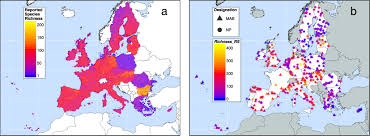Evaluation of EU Special Protection Areas for Birds Reveals Mixed Results

A study by researchers at the University of Göttingen and the Dachverband Deutscher Avifaunisten (DDA) has assessed the effectiveness of Special Protection Areas (SPAs) within the Natura 2000 network in Germany. These areas, designated by EU member states to protect bird populations, show varying levels of success in supporting avian species, particularly rare ones. Published in *Biological Conservation*, the study highlights the potential of citizen science in providing valuable data for conservation efforts.
The researchers utilized the citizen science platform ornitho.de, which aggregates over 90 million bird observation records contributed by thousands of participants across Germany. While the SPAs are generally well-placed, the findings indicate that only a few bird species thrive better within these protected areas compared to similar unprotected sites.
Dr. Femke Pflüger, the study's lead author, pointed out that 62 percent of the studied species were more likely to be found in SPAs than outside them. However, a temporal comparison from 2012 to 2022 revealed that only 17 percent of the species showed positive developments in protected areas, predominantly among meadow birds like black-tailed godwits and curlews, which benefited from specific habitat management efforts. Conversely, 83 percent of species either had no measurable impact or fared worse within SPAs compared to unprotected regions.
Professor Johannes Kamp, head of the Department of Conservation Biology at Göttingen, emphasized that merely designating SPAs is insufficient to reverse declining trends in bird populations. He called for improved staffing and funding to enhance habitat restoration and targeted conservation measures for endangered species.
The study underscores the power of citizen science, as thousands of contributors enabled the tracking of significant changes in birdlife. Dr. Jakob Katzenberger noted the success of utilizing online platforms for biodiversity data collection, demonstrating their immense potential for conservation research.
This research was supported by funding from the German Federal Agency for Nature Conservation (BfN) as part of the project aimed at harmonizing bird monitoring efforts in EU special protection areas.
Story Source:
Materials provided by University of Göttingen. The original text of this story is licensed under a Creative Commons License. Note: Content may be edited for style and length.
Journal Reference:
- F.J. Pflüger, C. Frank, M. Busch, J. Wahl, R. Dröschmeister, C. Sudfeldt, J. Kamp. Semi-structured citizen science data reveal mixed effectiveness of EU Special Protection Areas (SPA) in Germany. Biological Conservation, 2024; 299: 110801 DOI: 10.1016/j.biocon.2024.110801

0 Comments